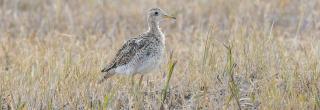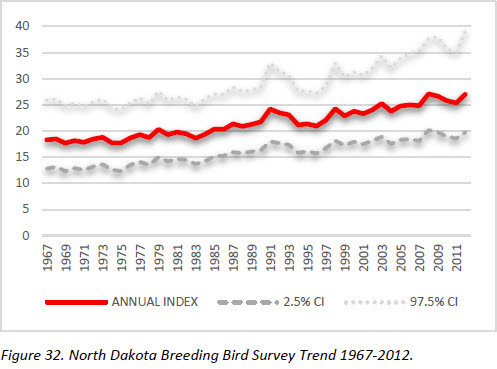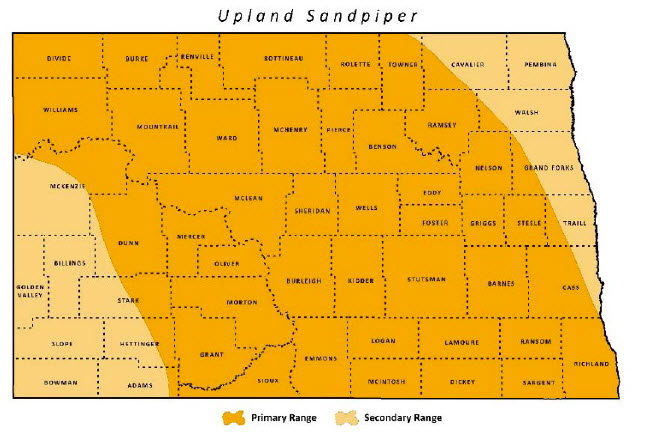
Upland Sandpiper
| Scientific Name | Bartramia longicauda |
|---|---|
| General Description | L 12”, WS 26”, 6 oz. A short yellow bill, long yellow legs, small head, slender neck, and a long tail characterize this shorebird. |
| Status | Occurs in North Dakota from mid-April to August. Peak breeding season occurs from late May to early July. |
| Abundance | Common. |
| Primary Habitat | Dry, open mixedgrass prairie. Often uses wooden fence posts for viewing. |
| Federal Status | Migratory Bird. |
| Reason for Designation | One-quarter of this species population breeds in the Prairie Pothole Region. Moved from a level I to a level II because populations appear stable to increasing. However, loss of grassland and CRP in North Dakota may cause populations to decline. It is included on the National USFWS Birds of Conservation Concern list, and also in Region 6, BCR 11 and 17. Least Concern in Shorebirds of Conservation Concern 2015. |
Locations and Conditions of Key Habitat
Preferred Habitat
Upland Sandpipers use native and tame grassland, wet meadows, hayland, pastures, CRP, cropland, highway and railroad rights-of-way. Densities may be highest in moderately grazed areas. Prefer predominantly mixed-grass cover, low to moderate forb cover, moderate litter cover, and little bare ground. Associated vegetation includes wheatgrass, Kentucky bluegrass, green needlegrass, needle-and-thread, buffalo grass, and smooth brome. Forage in short vegetation (less than 10cm) for small invertebrates which constitute over 95% of their diet. Nest and rear broods in taller vegetation (10 to 60 cm). Although the Upland Sandpiper is a shorebird, it is almost never seen by water.
Key Areas and Conditions for Upland Sandpiper in North Dakota
No specific sites have been identified. Upland Sandpipers are locally common throughout Prairie Pothole Region and rarer in the Missouri Slope.
Problems Which May Affect this Species
Habitat
Conversion of grassland to cropland, energy development and urban expansion. Degradation of grasslands from invasive plants, woody encroachment, succession, and loss of diversity. Deemed woodland-sensitive, occurrence declines with increasing tall shrub (>1m) cover.
Other Natural or Manmade Factors
Prior to the Migratory Bird Treaty Act, Upland Sandpipers were heavily harvested and nearly extirpated. Shooting may still be a problem in South America, as well as use the use of insecticides and other agrochemicals. Early mowing can destroy nests or kill the adult female on nest. Death from collisions with vehicles or power lines occurs, but is rare.
Research and Survey Efforts
Current Research or Surveys
- Since 2004, the USFWS HAPET staff has coordinated a breeding shorebird survey in the Prairie Pothole Region of North and South Dakota. Surveys are conducted twice to correspond with the shorebird breeding season. Five grassland breeding shorebird species are targeted, including Upland Sandpiper. Results from these surveys help guide grassland and conservation efforts.
Previous Research or Surveys
- The Nature Conservancy (ND SWG T-31-R) determined grassland bird response to decreased in grazing pressure in the Sheyenne River Delta area. The project was initiated in April 2011 and a final report provided in 2014. Upland Sandpiper abundance was higher in areas with more open, sparse vegetation. They but had a positive relationship with burning, grazing intensity and variability in letter depth but avoided recently burned areas (Ahlering 2014).
- Ducks Unlimited (ND SWG T2-2-R) determined wetland occupancy by shorebirds in wind energy developments in the Prairie Pothole Region of North Dakota. The project was initiated in 2009 and a final report provided in 2011. Results indicate wind energy was probably not causing substantial reductions in shorebird occupancy, including Marbled Godwits. However, apparent presence of shorebirds was low and potential effects of wind development on shorebird populations needs further research and monitoring (Walker and Gleason 2011).
- Delta Waterfowl (ND SWG T-13-R) determined shorebird nest success and nest-site selection in northeast North Dakota. The project was initiated in 2005 and a final report provided in 2007. Vegetation surrounding shorebird nests was relatively short, sparse, native grass species. Shorebirds avoided sites dominated by invasive plants (e.g. leafy spurge, Canada thistle, Kentucky bluegrass, smooth brome, stinging nettle, and wormwood.) Habitat has a stronger impact on shorebird nest success than predator removal (Wiens 2007).
- Ducks Unlimited (ND SWG T-3-1 and T-8-R) determined demographic performance of prairie-nesting shorebirds in North Dakota. The project was initiated in 2004 and a final report provided in 2007. The highest reproductive success for shorebirds was in those areas with high amounts of grassland, low levels of edge between cropland and grassland, and high amount of wetland area. Preserving large intact grassland/wetland landscapes are key to safeguarding populations of Upland Sandpipers (Stephens and Walker 2007).
- Numerous published reports and gray literature on this species throughout its range.
Additional Research or Surveys Needed
Demographic information.
Population and Trend Estimates

- North American Population Estimate 2012: 750,000
- North Dakota BBS Trend: see figure 32
- Survey-wide BBS Trend 1966-2012: -0.23
Management Recommendations
- Maintain large (>100 ha) contiguous blocks of native prairie or grassland.
- Allow some blocks of grassland to be undisturbed during the nesting season.
- Avoid burning and mowing during the nesting season and delay spraying and mowing until July 15.
- Provide display perches such as wooden fence posts.
- Prevent encroachment of or remove woody vegetation.
- Moderate grazing provide diverse grass heights. Delay grazing until late May to early June.
Monitoring Plans
The Breeding Bird Survey continues to be a useful monitoring tool, however the annual surveys implemented by HAPET in 2004 are valuable. Ensuring all BBS routes are conducted annually is priority. A shorebird monitoring plan should follow The International Shorebird Survey (ISS) Program for Regional and International Shorebird Monitoring (PRISM) and “Guidance for Developing and Implementing Effective Shorebird Surveys.”
2005-2015 Progress
The Upland Sandpiper was reassigned from a Level I to a Level II Species of Conservation Priority due to stable population trends. Several State Wildlife Grant Projects (T2-9-R, T2-11-HM, T-18-R, T-21-D, T-22-HM, T-23-HM, T-25-HM, T-27-HM, T-37-D) have contributed to habitat enhancement of wetlands and grasslands for Upland Sandpiper and other wetland/grassland dependent birds.

Note: A listing of works consulted when compiling the information on this page may be found in the 2015 State Wildlife Action Plan.
